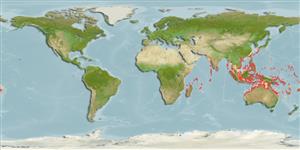Environment: milieu / climate zone / depth range / distribution range
Ekologi
laut berasosiasi dengan karang; nir-ruaya; kisaran kedalaman 4 - 40 m (Ref. 7247). Tropical
Indian Ocean: South Africa to Kenya, Maldives to the Andaman Sea and Australia. Previous reports from the Western Pacific (Taiwan, eastern Australia and Vanuatu Island) most probably refer fo Chromis xanthura (Ref. 129596).
Size / Weight / umur
Maturity: Lm ? range ? - ? cm
Max length : 17.0 cm TL jantan/; (Ref. 90102)
Duri punggung (Keseluruhan (total)): 13; duri punggung lunak (Keseluruhan (total)): 10-11; Duri dubur 2; Sirip dubur lunak: 10 - 11. This species is distinguished by the following set of characters: D XIII,10-11 (mode 11); A II,10-11 (11); pectoral-fin rays 18-20 (19); upper and lower procurrent caudal-fin rays 3; pored lateral-line scales 17-18 (18); gill rakers 6-8 (7) + 19-22 (21) = 26-30 (28); the longest dorsal fin soft ray length 24.6-36.4% (mean 29.4%) of SL; first anal-fin spine length 6.5-8.4% (7.1%) of SL; caudal-fin length 43.9-59.8% (48.6%) of SL; posterior tips of caudal-fin lobes filamentous; presence of broad black bands along preopercular and opercular margins, sum width of two bands 15.3-27.9% (23.6%) of head length; in adults, the distal half of soft-rayed portion of dorsal fin is transparent; no triangular black blotches at the upper or lower caudal-fin base; caudal peduncle and fin are tinged yellow; soft-rayed portions of dorsal and anal fins are yellowish, while spinous portion of dorsal and pelvic fins dark blue in juveniles (Ref. 129596).
Adults inhabit outer reef slopes and deep lagoons (Ref. 9710). They form small to moderate aggregations on reef crests with moderate currents (Ref. 48636). Oviparous, distinct pairing during breeding (Ref. 205). Eggs are demersal and adhere to the substrate (Ref. 205). Males guard and aerate the eggs (Ref. 205).
Life cycle and mating behavior
Kematangan | Reproduksi, perkembang biakan | Pemijahan | telur-telur | Fecundity | Larva
Oviparous, distinct pairing during breeding (Ref. 205). Eggs are demersal and adhere to the substrate (Ref. 205). Males guard and aerate the eggs (Ref. 205).
Motomura, H., H. Nishiyama and S.N. Chiba, 2017. Review of the Chromis xanthura species group (Perciformes: Pomacentridae), with description of a new species. Ichthyol. Res. 65:177-191. (Ref. 129596)
Status IUCN Red List (Ref. 130435)
ancaman kepada manusia
Harmless
penggunaan manusia
Perikanan: tidak ada kepentingan
informasi lanjut
AcuanBudidaya airprofil budidaya airStrainGenetikaElectrophoresesDiturunkanPenyakit-penyakitPengolahanNutrientsMass conversion
mitraGambarStamps, Coins Misc.Suara-suaraCiguateraKecepatanTipe renangArea insangOtolithsOtakPenglihatan / visi
Alat, peralatan
laporan khas
muat turun XML
Sumber internet
Estimates based on models
Preferred temperature (Ref.
123201): 24.5 - 29, mean 27.9 °C (based on 668 cells).
Phylogenetic diversity index (Ref.
82804): PD
50 = 0.5000 [Uniqueness, from 0.5 = low to 2.0 = high].
Bayesian length-weight: a=0.01259 (0.00579 - 0.02736), b=3.03 (2.84 - 3.22), in cm total length, based on LWR estimates for this (Sub)family-body shape (Ref.
93245).
Trophic level (Ref.
69278): 2.7 ±0.31 se; based on food items.
Daya lenting (Ref.
120179): sedang, Waktu penggandaan populasi minimum 1.4 - 4.4 tahun (Preliminary K or Fecundity.).
Fishing Vulnerability (Ref.
59153): Low vulnerability (10 of 100).
Nutrients (Ref.
124155): Calcium = 83.8 [48.9, 124.1] mg/100g; Iron = 0.709 [0.463, 1.061] mg/100g; Protein = 18.6 [17.6, 19.6] %; Omega3 = 0.142 [0.097, 0.206] g/100g; Selenium = 26.1 [16.2, 44.2] μg/100g; VitaminA = 113 [40, 313] μg/100g; Zinc = 1.8 [1.3, 2.4] mg/100g (wet weight);
